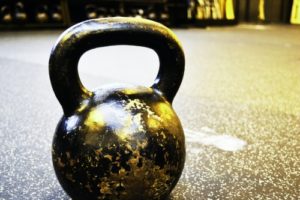 I’ve been, like all of us, stuck at home in quarantine during Covid-19. As far as strength training goes, that means that I have three kettlebells at my disposal and nothing more. At first I was worried about it, but I’ve relearned the value of simplicity and frankly, I think I’ve made more progress precisely because of the limited options.
I’ve been, like all of us, stuck at home in quarantine during Covid-19. As far as strength training goes, that means that I have three kettlebells at my disposal and nothing more. At first I was worried about it, but I’ve relearned the value of simplicity and frankly, I think I’ve made more progress precisely because of the limited options.
Making Due With What I’ve Got
At home, I have two fifty-pound kettlebells and one thirty-pound kettlebell. With only these three weights I decided to narrow my workout to essentially five exercises: kettlebell front squats, kettlebell hip thrusters, weighted push ups, kettlebell overhead press, and single arm bent over row. There are of course other options like lunges, floor presses, and the like, but these five are best for me and they are easily done in a small space.
Along with the simple selection of exercises I have an extremely small array of loading options. In the squats I can do thirty pounds, fifty pounds, one hundred pounds, or one hundred thirty pounds (with the aid of a backpack). Single arm rows are even more limited. I can do thirty, fifty, or eighty. Push ups are either body weight or with an extra thirty pounds or fifty pounds. That’s it!
Getting Creative With Sets And Reps
With so few options and relatively large jumps in weight I’ve had to rely on rep schemes to make progress. I do front squats with one hundred pounds for sets of six at first, then I do sets of eight, then ten, and finally twelve. Once I can do twelve I add thirty pounds, drop back down to six reps, and then work my way back to twelve again. If a jump feels particularly hard, I might also change the number of sets. In other words, instead of doing four sets of six I’ll start with three sets of six. Sometimes I build up to five sets of something before making a jump in weight, if I need to.
The program is obviously pretty simple, but that simplicity has several advantages. First, it makes me incredibly focused. I don’t have to consider if I am going to do front squats or back squats or overhead squats or kettlebell squats. I don’t have to worry about whether I am going to go heavy or light. There are no decisions about adding five pounds or ten pounds, no choices between cable rows or dumbbell rows. Secondly, and relatedly, the lack of decision making is a mental boost. There is no opportunity to say “I’m not feeling heavy squats today, I’ll deadlift instead.” I know I am doing kettlebell front squats and I have a couple of options on reps and weight and that’s it—I just have to get it done, end of story! Finally, tracking is easier. I can clearly see what level of intensity I did last week versus this week without having to compare different versions of exercises to each other. If I did four sets of six at one hundred pounds for two weeks, then it’s time to add the thirty. No muss, no fuss.
I guess even trainers need to be reminded—maybe especially trainers—that more is not better. Sometimes the best way to make progress is to throw out the bells and whistles and just get down to basics.


